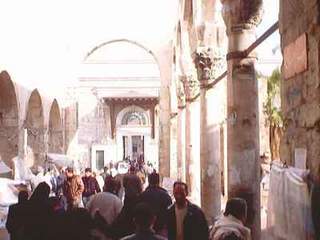Syria is floating on a lake of artifacts. In alHasaka (alJazira) alone there are more than 1500 archaeological sites. To continue, we can mention uncountable sites in the south; in the Golan, in Hauran, in alSweidaa, and in the north; in Aleppo, and Idleb, and in the East; in Palmyra, Deir Ezzor and alRaqqa, and also in the west ; in Lattakia, Jableh and Tartous. Damascus might be the capital of all these archaeological and historical sites. It is not only the oldest living town on earth, but it is the only living museum in the Globe. What increases the element of excitement in the Umayyad’s capital is that the greatest artifacts are still buried underground, although some of them, emerge , from time to time, so that our eyes can see them, our minds assimilate them but our imagination can not behold them.
In a special study, issued by the Ministry of Municipal Affairs, (now the Ministry of Housing), Mohammad Abul Faraj alUch, the late researcher and director of historical documents in the General Directorate of Archaeology & Museums narrated a story he had heard from an elder cousin, that when he was a child he used to, with some of his mates, to infiltrate through a hole in a basement of a house between Bab al Jabia and Souk Madhat Pacha, to go down into a large dark space, and a road lined with broken columns laid on the ground. The children used to walk hundreds of steps to a point believed to be under the present alBuzouria Souk. Mr. alUch recalls that the Roman Senate was located in this place opposite al Buzouriah Souk where as the Roman theater was in the place of the present Tailor’s Souk, on the right side of the Straight Street which is believed to be one meter under the present (Madhat Pacha Street).
The nature of constructions in this area prevented archaeologists from unearthing these great remains, but others, located in other places, emerged after removing unimportant buildings, I mean the southern wall of the Umayyad Mosque which was concealed under some stalls built in the early 20th.century. When these stalls were removed the gate of John the Baptist’s Church appeared.
This gate was mentioned in Numan alQasatli’s book titled “alRawdah (Paradise) in Dimashq alFaihaa”, Prosperous Paradise in Fertile Damascus, printed in Beirut on 1879. AlQsatli had seen that door with his own eyes before being concealed by the stalls and it is the same gate of Hadad’s Temple where the Umayyad Mosque was built. It seemed that the Christian monks had added Greek inscriptions, still apparent, on the gate, which say: “Your heaven my lord is eternal, and your powers extend through ages”.
When speaking about the eternal artifacts unearthed in Damascus one can recall two of the oldest and greatest sites in this city, among other tens of sites unique in Damascus and worthy to be visited. The first is the historical wall which parts of it are still intact, built during the Canaanite and Aramaic periods, two thousand years before the birth of Jesus Christ, in the south eastern part of Old Damascus and in the northern part.
What attracts in these parts is the large rocks used in building the wall at that time.
The second remarkable thing to be seen is the old gates of Damascus, a single honor no other city in the world enjoys now. You might see an old gate here or there but to find all the old gates, nearly intact, is a rare privilege of Damascus. All the seven gates built before the Islamic conquest in the seventh century AD are still standing. Sultan Noureddin al Shahid (Zenghi) added two other gates in the 12th century AD namely AlSalamah (Security) and alFaraj (Relief).
To be honest we have to say that another gate, AlNasr (Victory) Gate was removed from the entrance of the main Souk (alHamidiya), when the Souk was built in 1863.
Haifaa Mafalani

